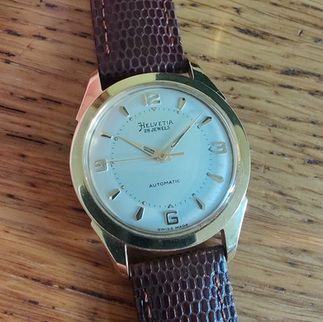
Helvetia Watches of the 1940s & 1950s
Following the war Helvetia's wartime production was funnelled into its civilian watches, including some of their most interesting watches.
Scroll down for more...
1940s Watches
During WW2 much of Helvetia’s manufacturing capacity was given over to the manufacture of military watches for both axis and allied countries. You can read more here about Helvetia’s WW2 German, American, British GSTP and Royal Navy Admiralty military watches.
Helvetia’s civilian watches also evolved during the war years. They moved from specialising in smaller waterproof and shockproof sports watches during the 1930s to a range of larger dress watches with chrome plated and solid gold cases via some interesting wartime watches.
Some of Helvetia’s nicest looking watches date from the immediate post war period. It appears that Helvetia increased production rapidly during the war to meet the demands of the military and this capacity was funnelled into the production of civilian watches post war.
As well as producing dress watches Helvetia also continued to manufacture military style watches as they were popular with the many ex-servicemen about at this time. They continued to provide these military style watches using their ‘3190’ waterproof screw back case, that had been used for military watches during the war, though mainly in a smaller 30mm version which was renamed ‘3190 P 30’.
At the end of the war they also introduced their calibre 800C centre seconds movement which replaced the calibre 820 of the war years.
By this time almost all of the watches of The General Watch Company were sold under the Helvetia brand name and in 1948 the company officially changed its name to Montres Helvetia or The Helvetia Watch Company.
1950s Watches
The 1950s saw a range of movements being developed by Helvetia. Firstly in approximately 1952 they produced a thinner central seconds movement; the calibre 830. The first watches to use this movement were very distinctive with large, applied, indices filled with lots of luminous compound. Despite these new movements some of Helvetia's earlier movements continued to be used, now fitted with Incabloc shock protection replacing Helvetia's own version.
There followed several automatic movements based on the calibre 830 manual wind movement, starting with the calibre 836 which was soon replaced by the 837 which became the subject of many reviews and much praise. See here for some articles about Helvetia's calibre 837 movement.
Many of the Helvetia watches that used these movements had quite a distinctive look reflecting the fashions of the day.
Helvetia also resurrected their large, 40mm, pilots watches for a short period in about 1955. They were upgraded with a stainless steel back and were fitted with the calibre 80C movement and a new shock absorber patented in 1950.
Helvetia’s movements and designs reached what was probably their peak during the 1950s. Helvetia had positioned themselves in the market to supply good quality watches with excellent movements at a price that the average worker could afford.




































